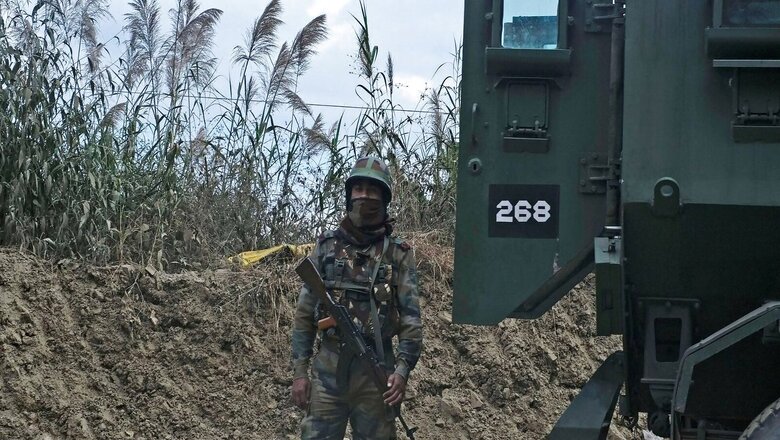
views
India has one of the largest numbers of border guarding entities and personnel in the world. One key reason is the volatility all around and a myriad of challenges that India faces from across the borders including issues related to terrorism, smuggling of arms, counterfeit currencies and narcotics, apart from human trafficking, cross border funding for radicalization, as well as illegal infiltration that is leading to ominous demographic shifts in border regions.
The Recent Augmentations
While capacity building of border guarding forces is a continuous and ever evolving process, some of the key challenges that have emerged in the recent past may have prompted the government to take some critical steps. This includes sanctioning of 12 additional battalions for Sashastra Seema Bal (SSB), extending BSF’s jurisdiction up to 50 km, proposed sanctioning of at least 7 more battalions for ITBP, which is expected to happen soon, to mention a few. Also, efforts are being made for capacity building in border guarding forces with both drone and anti-drone systems.
Should India Fence Indo-Nepal Border?
There are a few pertinent matters that may need deliberations now by the government and especially by the home ministry. The first among them is the issue of fencing India’s 1,770 km-long border with Nepal and 699 km-long border with Bhutan. In principle, India always have had an open border policy with Nepal because of the special relation between the two countries due to which even the citizens of the two countries can travel to each other’s territory without the necessity of a visa.
In essence, cultural, economic, historical and traditional bondages between the two countries, and especially people to people connect, played key roles for India to opt for an open border policy especially with Nepal, and Bhutan as well. However, the fact that there is a dedicated border guarding force namely SSB to secure the Indian side of borders, is proof enough that New Delhi was always aware of the cross-border challenges emanating from across the northern borders in spite of time-tested people to people and government to government relation.
SSB’s force strength is by no means trivial. With an estimated 1 lakh personnel at its disposal, a sizeable proportion of which is deployed in the borders on a continuous basis, and is equipped at par with other Central Police Forces, SSB over the years has often played a key role in preventing human trafficking, seizure of counterfeit products including fake currencies and narcotics, as well as have detained many suspected terrorists and Maoists.
However, the harsh reality and the flip side of the open border policy is that the Indo-Nepal border has been misused to the hilt by Pakistan’s deep state to sneak in men, money and materials for orchestrating all kinds of nefarious activities in India. Over the years, even as India strengthened its border guarding architecture along its western borders, and created a comprehensive counter infiltration grid along LoC, Pakistan found it more convenient to optimally exploit India’s open border with Nepal to give shape to its sinister agenda inside India. For India therefore, creating an impregnable counter infiltration grid along the LoC or stringent vigil along western borders perhaps become less than optimally effective because of its open border policy with Nepal.
The China Factor
Also, with China’s increasing entrenchment and stranglehold on Nepal and Bhutan, and with deteriorating Sino-Indian relationship showing no signs of thaw, possibility of the open Indo-Nepal and Indo-Bhutan borders being used by PLA for undertaking malicious activities inside Indian territory cannot be ruled out either. Even though in the recent past, SSB’s force strength has been enhanced by the Union Home Ministry with the sanction of 12 additional battalions, the fact that the border remains unfenced, poses major challenges for the men on ground. In spite of their best intentions to sanitize the entire border, being unfenced, these borders remain major areas of concern especially in the realm of hybrid war.
Therefore, it is high time, given the altering landscape of south Asian geopolitics along with China’s not so benevolent designs, that the government consider fencing the Indo-Nepal and Indo-Bhutan borders. No one denies that there are complexities involved in fencing these borders, including issues of demarcation, difficulty posed by the terrain as well as possible resistance from locals from both sides due to their close relationship and their bondage spanning from cross-border marriages, shared customs to festivals. Nevertheless, fencing is now a must along with proper floodlight facilities, and access control, for the greater cause of maintaining internal security.
Extending Jurisdiction of SSB on lines of BSF
In the same league, it also becomes imperative for the government to consider enhancing the jurisdiction of SSB to 50 km from the international border, at par with similar enhancement of jurisdiction for BSF made in a uniform manner across all areas under mandate of BSF. The rationale behind the same may be similar for which the jurisdiction of BSF was enhanced.
The Case for Greater Vigil of Indo-Myanmar Border
On similar lines of fencing the Indo-Nepal border, there is also a pertinent need for enhancing the level of vigil along the 1,643 km of unfenced Indo-Myanmar border. Over the last few years, Northeast India has witnessed considerable improvement in law and order situation with the overall security landscape remaining tranquil and issues of development increasingly taking centre-stage. Cross-border strikes by Indian Armed Forces on militant camps, as well as cooperation of neighboring countries like Bangladesh and Myanmar have ensured insurgent groups increasingly getting on the back foot with diminishing support base. Nevertheless, insurgency, even though on declining mode, is not extinct entirely.
The recent tragic incident, in Manipur, of the ambush on Assam Rifles Colonel Viplav Tripathi, his family and security escorts, once again underlines the simmering issue of porous, sparsely guarded and unfenced Indo-Myanmar border, and the manner in which it has often been possibly used by insurgent groups based across borders to sneak in men and weaponry, with impunity. Further, the menace of narcotics trade through the porous Indo-Myanmar border is also profound and needs to be plucked. Problem with Assam Rifles, which presently guards the Indo-Myanmar border, is that with a mere 46 battalions at its disposal, it is an onerous task for Assam Rifles to undertake the dual task of border guarding and counterinsurgency operations without facing the challenges of severe manpower deficiencies.
A few years ago, the proposal for guarding Indo-Myanmar border by any dedicated border guarding force such as ITBP or BSF, and taking it away from Assam Rifles, had been brought on the table of the government, especially after the June 2015 ambush in Manipur on an Indian Army convoy from Dogra Regiment that resulted in death of 18 soldiers and injury to 15 others.
Indian Army, on the other hand, which has the operational control of Assam Rifles has been reluctant to give up on its control of the Indo-Myanmar border since as per them, it would hamper their counter-insurgency operations in the northeast. Also, according to the reports, the operational knowledge of Assam Rifles, integrated with Indian Army, helps the Army prepare better for any kind of exigency situation arising out of that border owing to potential and evolving threats from China. Incidentally, there were also media reports in 2019 stating that Assam Rifles may be taken off the operational control of Indian Army and merged with ITBP. However, no progress has been witnessed on the same since then.
Deploying BSF, ITBP or Enhancing Strength of Assam Rifles?
The bottom-line nevertheless is that the guarding of Indo-Myanmar border needs to go a few notches higher and existing gaps therein are needed to be taken care of, on a priority basis. For that, either the Indian Army should solicit with the government to sanction more battalions for Assam Rifles, perhaps more than a dozen to the least, or else, the Ministry of Defence should hand over the control of the Indo-Myanmar border to any of the existing border guarding forces such as ITBP or BSF while allowing Assam Rifles to focus entirely on counter insurgency operations. Either way, something has to be done and present status quo would not serve any purpose. Given the declining relationship with China, the possibilities of the porous border with Myanmar being potentially exploited, much on the lines of similar apprehensions surrounding the Indo-Nepal border, cannot be ruled out either. This is why the need to restructure the border guarding architecture along Indo-Myanmar border, with development of better infrastructure and deployment of more personnel along the border, is so very profound.
Create Economic Hubs in Border Regions
A fundamental challenge that India is facing is a continuous process of migration, both seasonal and permanent, that is happening from hundreds of villages in the vicinity of the Indo-China border along Uttarakhand, Arunachal, Himachal and Sikkim. Part of the reason has to do with weather which has traditionally compelled rural populace from extreme northern areas to migrate towards the plain land during the advent of winters and return again just before spring.
However, over the last couple of decades, this trend of migration is increasingly taking a turn of permanency as rural populace prefer to shift towards towns and cities in search for better livelihood. This poses a major danger for India’s border regions where the local folks often play the role of eyes and ears on ground to inform about enemy encroachments or appearance of foreign elements. In case of Kargil war as well, the first information on the Pakistani soldiers who had sneaked in, was given to Indian Army by the local shepherds of Kargil.
For India, while the border guarding forces continue to do their job with utmost proficiency, no force on ground can keep vigil on every inch unless ably complimented by support from local populace. Given the increasing instances of attempts of China to orchestrate ‘salami slicing’, it is increasingly important for India to have a border specific economic policy combining agriculture, ecotourism, adventure sports and development of MSME sector to make sure that areas in the vicinity of border do no longer remain barren lands but become hotbed of economic activities to attract people from hinterland that would make sure that any surreptitious attempt of illegal encroachment by an adversary is nipped in the bud. People would not migrate away from their ancestral villages if the right kind of economic opportunities are created for them near their abode.
While respective states may have their own policies to deal with this issue, India may need a vibrant national policy on the same. Also, it has been witnessed that wherever army garrisons, regimental centres, brigades, cantonments, air force stations or defence academies come up, those areas record major economic progress as the armed forces establishments act as catalysts to trigger economic activities. India should attempt something similar by giving land near border areas, especially along the Indo-China border to armed forces and central police forces for setting up their academies, training units as well as bases. This would help in both raising the spectrum of economic activities as well as the quantum of surveillance.
The government may also consider to assist border states along the norther borders to set up specialized Border India Reserve Battalions (BIRB) on the lines of IRBs set up until now for internal security purposes. Those India Reserve Battalions specifically meant for borders may specifically recruit locals that may do wonders to retain people in border areas.
Centre Should Directly Deal with Organised Crimes along Border
While the home ministry has enhanced the jurisdiction of BSF up to 50 km from international border, a question may arise whether the efficacy of such enhancement of jurisdiction can become more effective if the border guarding forces, especially BSF is also given the right to prosecute cases with cross-border connection or is given the discretion to handover suspects directly to NIA as and when it deems a case fit for that. While allowing BSF the right to prosecute may stir a hornet’s nest with certain political parties would surely try to create a furor over it, fact remains that there are enough apprehensions surrounding the instances of suspects arrested and handed over to respective police state police forces by BSF, and with how much sincerity the respective states then pursue the cases, prosecute suspects, take such cases to logical conclusions to punish perpetrators and create demonstrable deterrence. A white paper on the same would make things clearer.
Given the changing dynamics of internal security, emerging concepts of hybrid war, external dimension of internal security, use of cross-border smuggled fake currencies, narcotics, and illegal infiltration to change demography or fomenting internal mayhem through radicalisation, there is a serious need for India to introspect as to whether leaving everything at the mercy of states in the name of ‘law and order being a state subject’ serves the purpose or whether India needs a new set of laws to deal with such crimes that have a cross border connect, which can be prosecuted directly by the prosecution wing of border guarding forces or organizations such as NIA.
One has to remember that while law and order is a state subject, anything that has national security implication has to be dealt with separately and cannot be equated with petty local crimes. While NIA has been given the mandate to deal with certain cases of fake currencies and narcotics emanating from across the borders, it would be ideal that BSF is given the discretion to hand over any suspect associated to any kind of cross border organised crime and organised illegal infiltration to NIA instead of handing over suspects to state police units.
Border Guarding Forces Should Not Be Deployed in Internal Security
Over the years, even as the government consistently enhanced the strength of central police forces and assisted the states with setting up of India Reserve Battalions, most states on the other hand have been reluctant to invest in capacity augmentation of their police forces. This has often led to increasing demand by states for deployment of central forces for law and order duties as well as anti-Maoist operations, forcing the Centre to often deploy companies of SSB, ITBP and BSF for such duties, apart from CRPF. This puts pressure on border guarding forces and their border deployment. Therefore, going back on the ‘one border-one force’ model, Union Government should ideally consider further enhancement in battalions of CRPF while relieving the border guarding forces from internal security duties.
The author is a geopolitical analyst. The views expressed in this article are those of the author and do not represent the stand of the publication.
Read all the Latest Opinions here




















Comments
0 comment